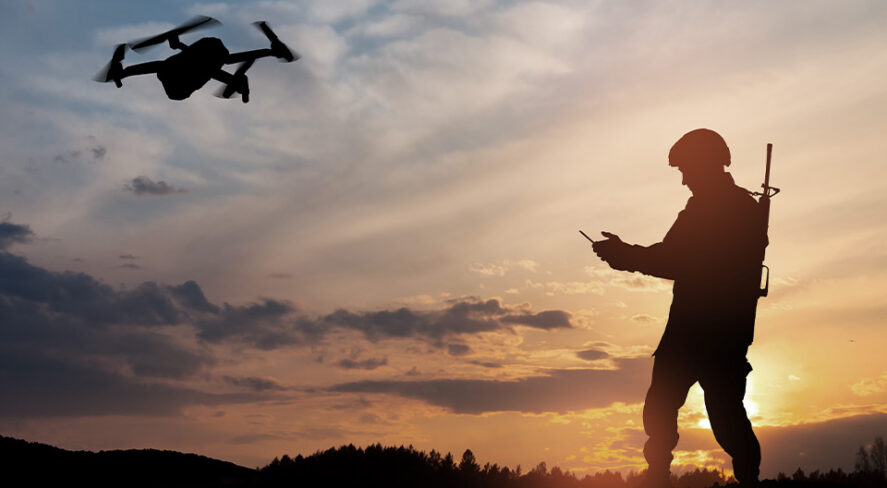Ukraine Is the World’s Drone Laboratory: How Does This Transcend Security in Society?


The war in Ukraine has brought us a ringside view of the most expansive drone technology testing the world has ever seen. Hundreds of simultaneous experiments of aerial, terrestrial and aquatic platforms are being used for combat operations. Real-time reports and researched articles surface daily and reinforce that drone technology is maturing precipitously. Many technological advancements have cascaded from the battlefield and are now used in nonmilitary applications, both as tools and as threats. Security professionals should look at this conflict with curiosity about the capabilities of drones, good and bad, and the need for fortifying domestic protection practices.

Overall, there are some shocking statistics from Ukraine concerning drone use. The first claims more than 6,000 individual platforms of various types have been deployed in the conflict and more than 10,000 individual drones are lost in combat operations monthly (loss is defined as the result of disablement by either electronic or kinetic disruption or battle damage). These numbers, if accurate, are astounding – they indicate the rapid adoption of cost-neutral technology which is largely accessible to the public and, when in the hands of nefarious operators, can mean elevated risk for private and commercial high-security sites.
So, what is an aerial drone? Before we move to the security practitioners’ challenge and opportunity as it relates to drones, let’s talk about how drones are defined and highlight some examples of their use in the Ukraine conflict. Drones typically fall into one of five classifications. Categories 1 and 2 are small drones, also known as small uncrewed aircraft systems (sUAS), and weigh under 55 pounds. Category 3 drones are considered medium-sized and range from 56 to 1320 pounds. Categories 4 and 5 drones are considered large drones and weigh more than 1,320 pounds. Most, if not all, publicly available sUAS fall into the Category 1 and 2 classifications and play a significant role in intelligence, surveillance and reconnaissance (ISR) missions or are used as first-person view attack platforms. Some examples of the platforms from each category include the Black Hornet (Category 1), DJI Mavic 3 (Category 1), Scan Eagle (Category 2), Panther (Category 3), Shadow (Category 3), TB-2 (Category 4) and Heron (Category 5). Other typical platforms being publicized are the Puma, Switchblade, Phoenix Ghost and Punisher, some of which are considered loitering munitions. In addition to these known and named platforms, there are a plethora of “do it yourself” platforms that are modified to deliver optimal impact in unique territories and circumstances.
There is a clear evolution in this conflict as each side realizes that “the enemy is not a potted plant.” So why is this significant? What we are seeing is a change in the way major combat operations are conducted. And, perhaps, a revolution in military affairs. As with any conflict, each side and its support infrastructure are capturing lessons learned as the conflict continues. This continuous adaptation to the realities of the battlefield not only fosters, but requires, creativity and innovation. All NATO categories of drones are in use in this conflict, including the cutting-edge Black Hornet Nano Drone. Plus, 1,000 additional systems have entered tactical ISR combat operations. It seems there are no limits to what is available or imaginable within the drone ecosystem, especially for missions intent on detection, monitoring and supporting “kill chain” operations in this modern, sophisticated and technical game of “cat and mouse.”
So why is the aspect of drones and related counter-UAS, or counter-drone, activity important for nonmilitary security professionals to understand? As drone activity in the nonmilitary space continues to rise, private and commercial organizations are considering their risk and how they will respond if a drone enters their airspace. Defining risk and need, and creating detection, tracking and interdiction (DTI) solutions that align with national, state and local laws on the domestic front is complex. The overwhelming amount of information available from a multitude of public sources has created an information-sharing advantage. Simply use your preferred search engine to search the topic, and your options are limitless. For the first time, the attuned military enthusiast, the commercial security guru and the idle observer have access to the usage and trends of drones and how trends will affect the future growth and maturity of the drone ecosystem. Like the cyber tidal wave over a decade ago, the technology associated with drones is evolving swiftly and creating a revolution in thought and action. The competing nature of the market, combined with the growth and emergence of refined maturing artificial intelligence that includes autonomous capabilities, is reshaping modern and nonmilitary security and safety. Despite the rapid change and complexity we’re observing as drones are used as tools in conflict zones, there is opportunity for refinement and growth that bolster the safety and security of public space and mass gathering venues.
In the case of Ukraine, drone technology has given the Ukrainian forces a semblance of parity to its counterpart, which boasts a much stronger and more developed military-industrial complex. This parity is predominantly reflected in the aerial and aquatic domains of the tactical fight but has had a significant impact on all levels of war (tactical, operational and strategic). Additionally, it is without a doubt that as drones promulgate the skies of Ukraine, so will the counter-drone technologies. In this conflict, Russia is exhibiting an extremely sophisticated and dense electronic warfare capability and using technologies to counter all categories of drones.
While asymmetric in comparison, a recent nonmilitary incident stateside points to the evolution of using drones to carry out nefarious and criminal activity. In New Hampshire, a drone was used to drop various payloads on people in homeless encampments. While this is certainly unkind, threatening and hurtful, imagine if the same tactic were used to deliver a disruptive payload to a major mass gathering, water treatment facility or nuclear power site where such a disruption has rippling, and sometimes life-altering, effects.
In the drone market ecosystem, we are observing a delineation between subverticals that exist within the technology space. It is important for security practitioners to be familiar with the market space and pace at which technology is advancing; a finger on the pulse means being prepared. Seven distinct sub verticals provide a comprehensive view of the drone ecosystem:
- Manufacturers and vendors of drone platforms (Capability development)
- Detection and monitoring technologies (Detect and track – D & T)
- Counter-UAS technologies (Interdict – I)
- Hybrid technologies that can detect, track and interdict (DTI)
- Drones as a security service (Information and intelligence gathering)
- Education and training (Consultants and subject matter experts)
- Rules, regulations and laws (Governments, departments and agencies)
Technologies, services and control mechanisms in each of these categories perform a specific function in the drone ecosystem, which often confuses the consumer. To further explain this from a use case perspective, let’s look at a mass gathering event for an open-air concert. For a security professional, there is a methodology that should be followed to allow the overall physical security program to assimilate the “air domain” into an operational or executable state. In general, this methodology follows this framework:
- Drone vulnerability and risk assessment
- Proactive air space reconnaissance (14- to 30-day test)
- Drone emergency response planning
- Policy and procedure development
- Detection and monitoring technology decision
- Rule, regulation and law review
- If approved, counter-UAS technology decision
- Staff and stakeholder training, rehearsals and exercises
- QRF formation (forensic capable platform exploitation)
- Operational employment and execution
- After action review
In our example, the security staff and key external stakeholders, including first responders, are taking on a level of complexity that is not part of daily operations, in part due to lack of historical risk and perceived lack of need. Based on the rapid evolution of drones and their use worldwide, we know that the need has changed, and perception should follow. As security professionals begin to assimilate the data, gain experience and explore drone detection and counter-UAS activity, a holistic system will be needed – one that considers and documents all the steps of the planning framework and where decisions are informed through risk assessment, proper planning and mitigative action.
The Ukraine-Russia conflict has acted as an agent of rapid change and an incubator of security technology and, if leveraged appropriately, will yield maturation of physical security, responsible counter-UAS operations, formalized training and cascading laws that support domestic security environments threatened by the “air domain.” We can no longer afford not to “look up.”
